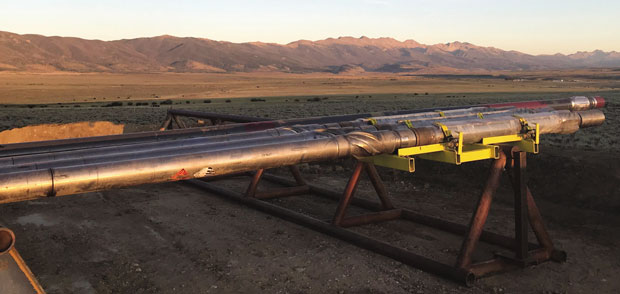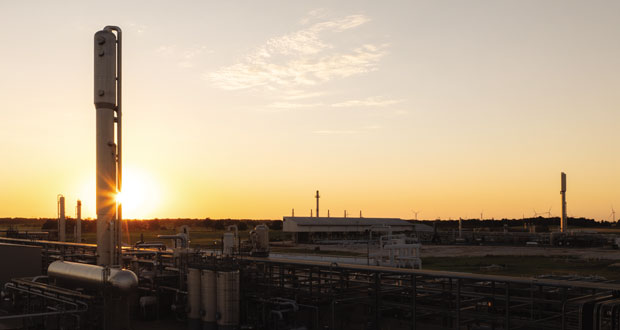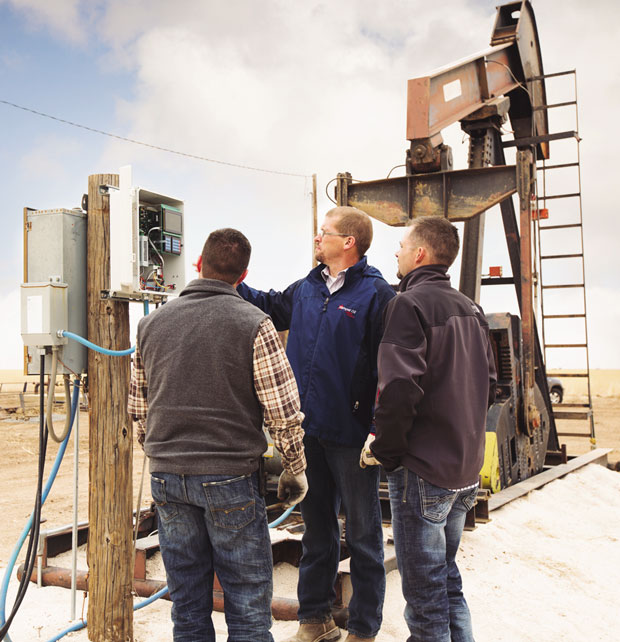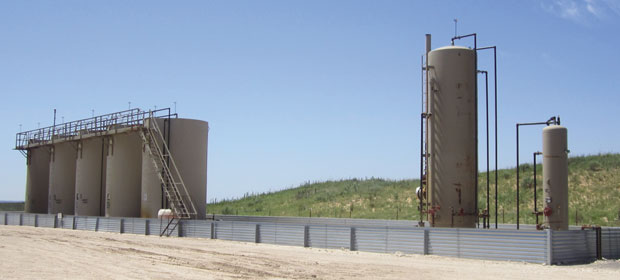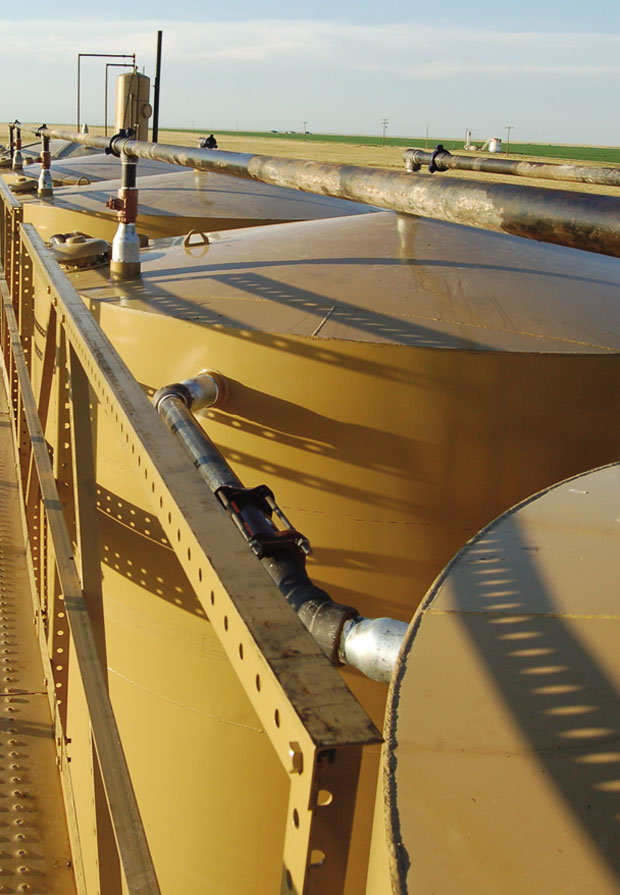
Conventional Targets In Bull’s-Eye For Operators In Anadarko Basin, Panhandle
By Danny Boyd
Everyone knows the growth of U.S. crude oil, natural gas and natural gas liquids production is driven by powerhouse new-well horizontal completions in unconventional basins. A star-studded lineup of high-rate plays with stacked pay zones has elevated the United States to the position of global oil and gas output leader, ahead of both Russia and Saudi Arabia.
But what is far less obvious to the casual observer is the pivotal role that conventional and legacy wells play in maintaining baseline production. Simply put, America needs both unconventional and conventional basins, and new wells with off-the-chart productivities alongside vintage wells steadily making a few barrels of oil equivalent per day.
Nowhere it seems is the value of both asset types more evident than in the Anadarko Basin in the Mid-Continent, which includes the likes of the SCOOP horizontal liquids-rich resource play and the Panhandle-Hugoton complex, once among the world’s largest conventional gas fields, extending from North Texas into Southwest Kansas. Across the region, players continue to reap the benefits of rich gas and liquids output from horizontal wells while legacy production from shallow layers of brown dolomite in the west continue to allow operators to take advantage of wellhead prices for high-Btu gas that fetches a premium wellhead price.
In the Anadarko Basin of western Oklahoma, Gulf Exploration LLC is taking nonoperated positions in the basin to exploit conventional opportunities elsewhere, while Mach Natural Resources continues to pace production with an extensive portfolio of properties. In the Texas Panhandle, independent companies Pantera Energy, Questa Energy and H&L Exploration are taking advantage of divestitures from larger companies and small private operators looking to wind down operations.
Nonoperated Position
Gulf Exploration LLC (Gulf) and affiliated Oklahoma City businesses that include Garrett and Company Resources LLC (Garrett) continue to grow nonoperated interests in unconventional Anadarko projects in western Oklahoma and drill vertically to expand a position across the Mid-Continent, says Gulf Exploration Manager Al Salomone.
Along with Garrett, the group participates as a nonoperator with larger players in projects developing the Cherokee in Roger Mills, Ellis, Custer and Dewey counties. The entities have similar participations in southern Oklahoma.
Gulf Exploration LLC and affiliated Oklahoma City businesses that include Garrett and Company are expanding nonoperated interests in unconventional Anadarko projects in western Oklahoma and drilling vertically to expand a position across the Mid-Continent.
“Like any entity, you have to build reserves to stay in business,” says Salomone, a partner with Pat Garrett since 1988. “It gives us the opportunity to work with an operator that is actively drilling wells and with people who can do it at a reasonable cost. We will continue to look toward these nonoperating opportunities to grow our reserves and grow the company.”
Throughout five states, Gulf operates about 83 vertical wells and holds interests in some 1,000 others. About 10 vertical/extended reach directional operated wells are planned this year, including four in central Oklahoma in the fourth quarter. In Nebraska, the company is installing a waterflood project.
A conventional project near Fall River, S.D., is on hold because of a lawsuit brought by the Earth Guardians environmental group against the U.S. Bureau of Land Management that affects development across more than 40,000 acres in the region, Salomone reports.
The combined companies have a storied Oklahoma history. In 1925, Otis Garrett, Pat’s grandfather, formed predecessor Gulf Production Corp. and, with prospects identified by his already up-and-running Garrett and Co., began operating oil and gas wells in Texas and Oklahoma and south of the border in Mexico. Gulf Production Corp. eventually would drill 43 wells in the historic Oklahoma City Field.
Otis eventually took major Gulf Oil up on an offer for the Gulf name in the Sooner State in 1944 and with his son Dick Garrett, Pat’s father, launched Coastal Oils Inc. as an operator in 1956. Coastal Oils Inc. began operating to develop company owned minerals in Oklahoma and in 1987 began taking over operations of troubled properties of others after the 1986 bust. After Chevron acquired Gulf Oil, the company reacquired the Gulf name.
The company began drilling in Oklahoma, Kansas and Wyoming and drilled 10 horizontal wells in the South Texas Austin Chalk before divesting of a sizeable block of assets, and then reloaded through Gulf and Garrett for another round of success.
Surging Interest
A consistent workhorse, the Anadarko Basin has become one of the hottest regions outside the Permian, with activity and transactions picking up in recent months as companies seek predictable results, assesses Tom Ward, chief executive officer of Mach Natural Resources.
The uptick provides the Oklahoma City-headquartered company the opportunity to prove up more acreage as others develop adjacent assets next to portions of a 1-million acre position that is 99% held by production and prospective of oil, gas and natural gas liquids, he says.
Mach Natural Resources is producing 89,300 boe/d across its 1 million acre position in the Anadarko Basin, consisting of 23% crude oil, 24% NGLs and 53% dry gas.
Higher mineral valuations from growing interests also are allowing the company to divest of noncore holdings as part of a strategy to maintain a reinvestment rate of less than 50% of operating cash flow and maximize distributions to unitholders, explains Ward, who has guided the company since its 2017 founding and was a co-founder of Chesapeake Energy.
Earlier in the year, the company divested of 13,000 acres prospective of the Cherokee Shale, where Mach still holds 40,000 proven acres on an overall position of 100,000 acres.
“We only sold a small portion so we can watch wells that are being drilled and determine if they can then compete with our other locations,” Ward reveals. “The fact is that we have a large amount of locations to drill, and we need to increase operating cash flow in order to get to those locations.”
Chiefly an acquisitions company, Mach also is on the lookout for potential opportunities outside the region after integrating 17 Anadarko Basin additions, the latest 62,000 net acres and production from Paloma Partners IV with core assets in Oklahoma’s Canadian and Grady counties and other properties in McClain, Caddo, Custer, Dewey, Blaine and Kingfisher counties.
The company uses its drilling program to stabilize production declines and reports output of 89,300 barrels of oil equivalent a day, which is 23% oil, 24% NGLs and 53% gas, Ward reports.
Mach continues to realize efficiency gains. Lease operating expense guidance is down 3%. Per-well costs in deeper condensate locations are $7.6 million, compared with initial estimates of $8.6 million. Cycle time is down to 10.1 days on Oswego wells and average lateral lengths are up to 6,000 feet from 5,400 feet, he says.
The company is running two rigs, the first in Kingfisher County, where Mach has successfully targeted the Oswego more than 200 times, and the other in the condensate window in Canadian County.
Acquisition Opportunities
Farther west in the Texas Panhandle, production companies are acquiring assets being divested by larger companies and purchasing other properties from smaller companies looking to exit the business.
With 1,500 wells producing 55 million cubic feet of gas a day across 440,000 acres, Pantera Energy Co. continues to take advantage of the ongoing shift, says President Jason Herrick.
“We still see companies release acreage outside their core portfolio and release opportunities back out to folks that are a little smaller like us,” remarks Herrick, chairman of the Texas Alliance of Energy Producers. “We see opportunities out here and consider ourselves one of the top players in the region.”
With 1,500 wells producing 55 million cubic feet of gas a day across 440,000 acres, Pantera Energy Co. is focused on shallow gas reserves in the Panhandle-Hugoton complex as well as secondary recovery projects.
He says the development potential of unexploited uphole zones is plentiful on many of the company’s producing wells, and properties often include some drilling opportunities.
Although open to acquisitions in the Anadarko after unconventionally developing a now divested Mississippian project in Central Oklahoma, the company counts the Panhandle-Hugoton complex and its shallow gas reserves as key to its long-term success.
His father, Scott Herrick, founded Pantera in 1982. The company’s first well, the Frances No. 1 drilled in 1985, is still producing in Beaver County, Ok.
After graduating from Texas A&M University and doing consulting work, Herrick joined his father’s company in 2001. With backing from longtime supporters, the company accelerated acquisitions. Early additions included West Panhandle Field assets from Parker & Parsley, followed by acquisitions from divestitures by Devon Energy and BP.
In 2019, the company acquired assets from Merit Energy that extended operations into Southwest Kansas. The purchase included a waterflood project, and Pantera has implemented three other waterfloods since then. A Roberts County, Tx., property includes some stacked sandstones at greater depths that may be a solid waterflood opportunity as well, Herrick says.
“We are actively looking for more secondary recovery opportunities and there are more opportunities to do them,” he comments.
Despite challenges to secure services and navigating the intricacies of working with 5,000 mineral owners, the company is focusing on development work after recently drilling a well in Kansas. Despite the region’s maturity, there are ample opportunities that can be identified the old-fashioned way: poring over well records, Herrick insists.
Most legacy production comes from the brown dolomite, called the Chase in Kansas, a thick rock at a shallow depth. Uphole recompletions can include acidizing and some fracturing to shut off older zones that can include watered-out layers on wells initially drilled in the 1970s and 1980s, he explains.
High-Btu Content Gas
Other Texas Panhandle operators are benefitting from high-Btu gas produced from many of the region’s shallow wells.
Questa Energy Corp. of Amarillo, Tx., is currently averaging $5/Mcf from rich-gas production of 1,500-1,600 Btu, relates President Tyler Rufenacht.
The company produces about 150 wells in the Texas and Oklahoma Panhandles, but dolomite production in the Panhandle, West Field of Texas is Questa’s bread-and-butter, he says.
Questa Energy Corp.’s focus is on rich gas produced from the dolomite in the West Panhandle Field of Texas, which earns a premium price at the wellhead.
Other properties in the Panhandle, East Field, which has similar geology but different field rules, produce more than 1,800 Btu gas in some areas that sells for more than $9/Mcf at the wellhead.
Decades ago, reservoir pressures on these shallow vertical wells were around 450 psia, but that has declined to less than 30 psia today, Rufenacht explains. With so much of the production under vacuum, wellhead compression is required. One Questa property includes five or six wells interconnected with poly pipe and tied to a compressor. Revenue from attractive pricing makes the investment well worth it, he says.
Like other small Panhandle production companies, Questa seeks niche locations with production and redrill potential for wells typically completed open hole. Subsequent treatment with nitrogen and acid helps maintain production at a decline rate of less than 5% annually on some properties, details Rufenacht, a vice chairman of the Panhandle Producers & Royalty Owners Association. A well on a lease in Wheeler County, Tx., is still producing at 101 years of age with an annual decline rate of 1%-2%.
“We have other wells that are producing the same right now as they were 10 years ago,” he adds.
Questa was founded in 1985 by his late father, Dale W. Rufenacht, who had moved to Amarillo from Kansas with Phillips Petroleum 10 years before. In a 50/50 partnership undertaken with a handshake, Questa and Rob McGarraugh, now president of Badger Operations in Perryton, Tx., embarked on a strategy to acquire distressed assets and other properties with subsequent development backed by field operation veterans.
A decade ago, Questa and others influenced the Texas Railroad Commission to allow for denser drilling on one well per 160 acres instead of one well per section in the Panhandle, West Field, which effectively expanded the drillable acreage held by smaller operators, Rufenacht recalls.
Talk of increasing power demand from things such as artificial intelligence data centers as well as expanding LNG exporting capacity gives area producers reasons to be optimistic about the potential for stable gas prices in the long run, he says.
“I do not think you can be in the natural gas business and be impatient,” Rufenacht remarks. “We would be gone by now if we were not patient.”
Applying Lessons Learned
To help make the most of new vertical wells, H&L Exploration LLC is taking lessons from its previous horizontal drilling experience, says company President Gib Brown.
H&L Exploration LLC is applying lessons learned from past horizontal drilling projects to conventional vertical drilling and field development in the Panhandle region.
Beginning in 2008, the company focused on drilling horizontal Cleveland Sands wells, ultimately completing 35 with sliding sleeves, the prevailing technique in the region during a time when mechanical limitations on some drilling rigs without top drives restricted lateral lengths.
The Amarillo company also drilled horizontally in the Marmaton, mostly in northern Roberts County, but rising costs and softer prices eventually influenced a shift back to conventional work. However, the horizontal experience arms the company with knowledge on how to improve conventional completions.
“We learned a lot in the horizontal days on the job and basically went back to school,” recalls Brown, a PPROA board member. “We learned about rock fabric, stress fields, treatment and other things that we previously had limited knowledge of.”
A predecessor company, H&L Operating, was founded in 1972 by Jim Holcomb, Frank Ladd and Dudley Stanley, who drilled for gas but eventually discovered the Booker North Upper Morrow oil field via the Sell No. 1 in Lipscomb County, Tx., Brown remarks. The field would extend into Ochiltree County, Tx., and north to Beaver County, Ok.
In 1999, the founders sold to employees Brown, a geologist by trade, and Ronnie Moon. The two worked to drill low-risk wells and reduce lease operating costs. Brown founded H&L Exploration in 2008 to acquire and develop other assets and later purchased the remaining interest in H&L Operating, which he divested of three years ago.
“That freed us up from fractured ownership of assets that were mostly gas,” Brown says.
For other great articles about exploration, drilling, completions and production, subscribe to The American Oil & Gas Reporter and bookmark www.aogr.com.














